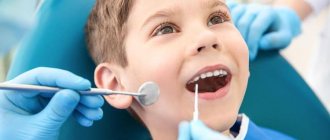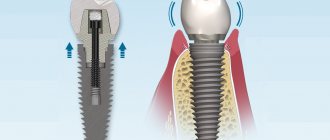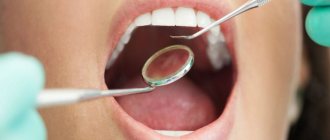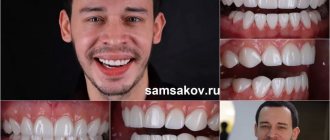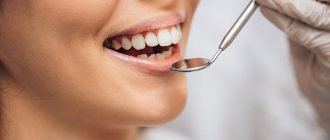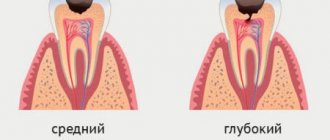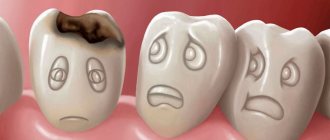What is dental caries?
This pathology can be called, without exaggeration, “dental enemy of humanity No. 1.” This disease affects 93% of the world's population. It was found even in people who lived 5-6 thousand years ago, and today caries in adults is the cause of tooth loss in almost 90% of cases. Moreover, it leads not only to the formation of the well-known “holes”. Subsequently, when the pathological process begins to spread to the surrounding areas, this causes the appearance of periodontitis, and then complete destruction of the tooth, which requires the irreversible removal of its remains and root.
Case from practice
I remember a patient who came to see me with advanced caries between her teeth. The destruction was significant, the girl was nervous, afraid not only of the dissection, but also of the injection. It is difficult to work with frightened patients; fears must be dispelled. Before administering the anesthetic, I treated my gums with Lidocaine, the girl realized that it wouldn’t hurt, and she calmed down a little. Fortunately, the pulp was not exposed, and the treatment was successful. But due to deep lesions on the lateral surfaces, both dental units had to be restored with ceramic crowns.
What are the causes of dental caries?
The cause of this disease is microorganisms that are present in large numbers in the human oral cavity. The destruction of first the enamel, and then dentin (the hard substance of the tooth) with further damage to the pulp chamber occurs under the influence of acids that these bacteria secrete during their life.
Their reproduction occurs especially intensively in the thickness of dental plaque, so periodic professional teeth cleaning is one of the most effective methods of caries prevention.
Reasons for appearance
There are many reasons for the development of the disease, but the most common is a violation of the dental treatment protocol. If during his work the master did not completely dry the cavity freed from caries, installed the light-curing filling incorrectly, poorly cleaned the affected areas, or chose the wrong composition of the filling material, the patient may later encounter the appearance of hidden caries.
Also, such a problem can be caused by loosening or too much shrinkage of the filling. Because of this, small chips and cracks may appear on the surface of the tooth, where pathogenic bacteria and food particles can enter. This pathology does not manifest itself in any way at first; it can only be detected when visible signs appear on the enamel: spots, dark areas, depressions.
If a person notices the appearance of severe pain even after eliminating the irritants, this may indicate that caries has affected the pulp chamber. Pulpitis is an inflammatory process affecting nerve fibers. In this case, it is not always possible to save the tooth; sometimes experts recommend installing an implant in its place.
Types of caries
This disease can be classified according to the localization of the pathological process:
- Cervical caries. In this case, the defect occurs at the border of the tooth and gum.
- Interdental caries. In this case, the lateral surfaces of two adjacent dental crowns are affected. Cavities between teeth occur mainly because these areas are quite difficult to clean with a toothbrush.
- Fissure caries. A fairly common option in which the defect appears in folds formed by hard tissue on the chewing surfaces of the tooth.
- Tooth root caries. An uncommon lesion, but the most difficult to diagnose, since the defect is hidden under the gum.
In addition, this disease has several stages of development. The following stages of dental caries are distinguished:
- initial, when the lesion looks like a dark or light spot on the tooth enamel;
- superficial caries, in which the pathological process develops only in the enamel layer;
- average dental caries, when the lesion has already spread to the upper layers of dentin;
- deep dental caries with the spread of the defect into the deep layers of dentin and further into the pulp chamber.
How to treat cervical caries
Treatment of the disease is carried out by a doctor. In the case of cervical caries, there are a number of reasons for immediately contacting a dentist:
- Rapid development of complications. In the cervical area, the thickness of hard tissue is minimal, so pulpitis and periodontitis occur more quickly than with other localizations of caries.
- High probability of crown fracture. Since the lesion tends to cover a large area in the gingival region, due to the softening of hard tissues over a large area, the tooth can break with a slight load.
- Visible aesthetic defect. Since cervical caries often affects the front teeth, their destruction is noticeable to others, which negatively affects self-esteem, personal life, and career.
Depending on the stage of the pathological process and the damage to certain teeth, treatment methods may vary.
Treatment of cervical caries of chewing teeth
The treatment method for cervical caries depends on the advanced stage of the disease. If in the early stages conservative treatment is sufficient, then in later stages it is impossible to do without drilling the carious cavity (local anesthesia is performed before drilling).
- Treatment of “chalk spot” and suspended caries. The traditional method is long-term use of products containing fluoride. The dentist applies medications to the affected tooth. At home, the patient uses fluoride-containing toothpastes and rinses to care for his teeth. A modern alternative method is the use of a complex system that includes etching the stain with acid and “sealing” the affected area with a polymer resin (ICON). Treatment is carried out in one visit. Before conservative treatment (by any method), professional tooth cleaning is required.
- Treatment of enamel caries with the formation of cavity and medium caries. Includes preparation (removal of affected hard tissue), treatment of the cavity with an antiseptic solution, thorough drying and filling. After drying, the filling is ground and polished. The procedures are carried out during one appointment.
- Treatment of deep caries. It consists of the same stages as for median caries, but after drying the cavity is closed with a therapeutic demineralizing bandage and filling.
In the treatment of cervical caries, they always try to preserve the living pulp (depulpation is performed only when pulpitis develops). Preserving the pulp is important because it is responsible for the production of dentin, the natural restoration of hard tooth tissue. A tooth with preserved pulp lasts longer than a pulpless one.
Treatment of cervical caries of anterior teeth
The principles of treatment of cervical caries of the frontal group of teeth, depending on the spread of the process, do not differ from those with damage to molars and premolars. However, there are some features associated with the fact that the front teeth are visible when talking and smiling. When restoring them, it is important to obtain a good aesthetic effect. To achieve this you can use:
- Fillings. At the Academy Dent clinic, modern light-curing composite materials are used to fill carious cavities. They imitate tooth enamel well and can be used to cover a defect unnoticed. The seal is made of high-quality material, installed in compliance with all rules, and lasts 10-15 years.
- Veneers. The installation of plates on the front part of the frontal teeth is indicated for extensive or combined defects (if, in addition to cervical caries, there is a chip or a violation of the position of the tooth). Porcelain and, especially, zirconium veneers compare favorably with composite onlays and fillings in their durability, impeccable aesthetic results, and do not accumulate plaque. The disadvantage of installing any veneers is the preparation of the entire surface of the tooth (including the removal of the entire layer of healthy enamel).
Treatment with folk remedies
It is impossible to cure cervical caries at home. Attempts at self-medication lead to a loss of time for conservative therapy, further tooth destruction and often to its loss. The use of folk remedies is practically not justified.
Diagnosis of caries
The diagnosis is made by the dentist based on the characteristic symptoms of caries and examination of external damage to the tooth. The stage of the pathology is clarified using radiography or radiovisiography.
How to cure caries?
Treatment of this pathology depends on the stage of its development. Thus, for caries at the spot stage, it is enough to remineralize the enamel using special solutions and pastes. And if the destruction of hard tissues begins, then mechanical cleaning of the cavity, the use of drugs that stimulate the restoration of dentin, and the installation of a filling will be required.
Particular attention is required in situations where the carious lesion has reached the internal cavity of the tooth, where the neurovascular bundle—the pulp—is located. In this case, inflammation develops - pulpitis, for the treatment of which it is necessary to fill the dental canals. These canals connect the pulp cavity to the jawbone and can become a pathway for infection to spread into the gum and tooth attachment area. And then periodontitis occurs there, which is one of the main causes of complete destruction and loss of the tooth.
The treatment method for caries complications is the most complex and consists of several stages:
- Pulp removal. Root canals are pre-cleaned using automatic or manual instruments. It is important to carefully remove all soft tissue so that in the future they do not become a source of inflammation.
- Sterilization. Then all bacterial microflora in the dental canal should be destroyed. For this purpose, dentists use special dental antiseptics.
- Formation of walls. The doctor tries, if possible, to straighten the canal and smooth out any protrusions on its walls. This will ensure the reliability and quality of the filling.
- Closing the canal with a filling. The channel is completely filled with sealed material. Particular attention is paid to tightly closing the root apex. At the end, X-rays are taken to control the quality of the filling.
- Tooth restoration. During this procedure, the anatomical shape of the tooth is restored, restoring its chewing function and natural appearance.
Features of the disease
The cervical form of caries is particularly aggressive and inconspicuous in its early stages. Symptoms of this form of caries can appear when the tooth appears intact at first glance. According to statistics, more than 70% of cases of cervical caries are detected too late, when the root canals are damaged or the neck of the tooth is fractured.
Dentists call root caries the most aggressive form of the disease. This statement is based on three significant factors.
The first factor is specific localization
The neck of the tooth, connecting the root and crown, has the thinnest layer of enamel. In addition, this part is covered by the gingival margin, which is why more bacteria and substances that contribute to the destruction of the hard surface of the teeth accumulate on its surface.
Since the thickness of the enamel on the neck is not large enough, and the degree of its mineralization is lower than on the crown, destruction occurs faster. As a result, caries deepens into the dentin and pulp in a matter of weeks, that is, many times faster than when the crown is damaged.
The second factor is specific distribution
Cervical caries tends to spread the pathological process under the gingival margin. In this case, the lesion not only goes deeper inside the tooth, but also around its circumference. This leads to the breaking off of part of the crown at an early stage of the disease.
Important! When the carious lesion covers the entire surface of the cervix, we are talking about the transition of cervical caries to circular. In this case, it is almost impossible to save the tooth.
The third factor is a blow to aesthetics or the invisibility of caries
When located on the front teeth, cervical caries cannot be hidden: it is clearly visible when talking and especially when smiling. This has an extremely negative impact on the psychological state of the patient.
Cervical caries located on chewing teeth, on the contrary, is often ignored and left without treatment. Therefore, more than 80% of patients with this diagnosis turn to dentists when the disease is complicated by pulpitis and the spread of the inflammatory process to the periosteum.
Why is this necessary?
- Preservation, not restoration of health. Even at the initial stage, caries is associated with varying degrees of destruction of dental tissue. Of course, the dentist will restore the tooth and form a filling, which will be installed in place of the missing fragment. But, in any case, the filling serves only as an analogue, a more or less effective replacement for lost dental tissue. Prevention does not allow the disease itself to develop. That is, it preserves the integrity of the natural structure of the tooth, eliminating the need to use artificial substitutes.
- Prevention is easier than cure. Treatment of carious lesions, especially in cases of large-scale spread, can be quite time-consuming. And at the same time, no one can guarantee that the disease will not appear again, on another tooth. Regular prophylaxis is much faster. This procedure only takes about an hour, does not require complex dental procedures, and should be performed on average only twice a year.
- Finally, prevention is cheaper than cure. From a financial perspective, caries prevention is also much cheaper than a full course of treatment. Therefore, by carefully monitoring the condition of your oral cavity and preventing the development of disease, you not only take care of your health, but also save money!
Prevention
Only careful oral hygiene can prevent the occurrence of cervical caries. In addition to brushing your teeth twice a day with toothpastes, it is recommended to use dental floss. To remove plaque from gum pockets and remove hard deposits, you need to visit the dentist twice a year and have your teeth professionally cleaned.
To maintain oral health, it is recommended to include fresh solid vegetables and fruits in your diet: apples, carrots, cabbage, etc. Dairy products as a source of calcium and phosphorus will be beneficial for your teeth.
When the first signs of cervical caries appear, you should make an appointment with a dentist and treat the disease before it becomes complicated by pulpitis.
Other
Can you take care of your dental health yourself?
Yes, sure. There are a number of rules that, if followed daily, will significantly reduce the risk of developing carious lesions:
- Brushing your teeth twice a day. Allows you to remove soft plaque in which bacteria multiply. To get rid of it reliably, you need to brush your teeth morning and evening with a brush that has medium-hard bristles. Each such procedure should last at least 3-4 minutes. A good solution would be to alternate fluoride-containing toothpaste (1 week) and fluoride-free toothpaste (3-4 weeks). This periodicity is due to the fact that enamel has a saturation limit with fluoride. A week of using fluoride-containing paste will provide the enamel with a sufficient amount of this element, and then fluoride will simply be removed from the body. But after a month, its concentration will decrease and its influx will be required again.
- Supplement the procedure with dental floss at least once a day, since the brush is not able to fully clean the spaces between the teeth.
- Regular brushing after meals. Residues should be removed by normal rinsing. It should be done after every meal. And to get rid of food particles that linger in the interdental space, it is best to use dental floss.
- Be careful with sweets! Bacteria that cause caries multiply much more intensively in an environment rich in sugars and fats. Therefore, instead of another cake, it is better to eat an apple or carrot. On the one hand, you deprive the bacteria of additional nutrition, and on the other, the solid consistency of such products itself cleanses the teeth and removes soft plaque.
The above preventive measures can be carried out independently. However, you cannot do without periodic assistance from a dental specialist. Therefore, we recommend contacting our clinic to determine the risk level of caries for you and your family members. And then, based on these results, SM-Dentistry doctors will develop an individual plan for preventive oral examinations for you. Constant preventative care will ensure your dazzling smile and the health of your entire oral cavity.
And of course, if acute symptoms of the disease appear, you should never self-medicate! This will only worsen the situation and cause complications. If you experience pain, we invite you for a consultation with a specialist at the SM-Dentistry clinic, call tel. or fill out the feedback form on our website.
Complications and consequences of internal caries
The soft tissues surrounding the tooth may also become inflamed. Sometimes the patient notes a general deterioration of the condition against the background of progressive carious lesions. His body temperature may rise, problems with the digestive system, bad breath, etc. may appear. Due to the negative effects of bacteria, flux and suppuration, cysts, and ulcers may appear.
Due to pain in the tooth, it becomes impossible to chew food normally, and a reaction to the slightest irritants appears. If the disease is not treated in time, periodontitis and periodontitis develop, which can result in tooth loss. This, in turn, is a serious stress and requires a long recovery.
Unfortunately, not all patients' caries disappears without a trace; some may encounter unpleasant complications both in the first days after treatment and several months after it. The most common phenomenon is an allergy to the materials used in the work. Sometimes infectious lesions are diagnosed, the cause of which may be the unscrupulous work of the doctor or failure to comply with the rules of personal hygiene.
previous post
White caries
next entry
Some additional facts
Just like that, after some time, the fillings do not need to be changed. The filling may remain with you for the rest of your life. Reason for replacement: breakage of a filling or tooth, as well as caries arising from the filling.
Minor caries is asymptomatic. By waiting for pain to appear, you are dooming yourself to more expensive and complex treatment.
In the treated tooth, caries stops. It may return after a while if the filling comes off and bacteria begin to penetrate into the resulting space between the filling and the tooth.
Often, caries occurs in places that are difficult to reach with a brush, for example, in the interdental spaces. That's why we strongly advise you to use dental floss.
Any cracks in teeth or fragments of teeth are at risk.
Not all tooth sensitivity indicates tooth decay. It can be caused, for example, by gum disease, which exposes the root of the tooth. In any case, only a doctor can name the reason.
When caries is detected in primary teeth, it is recommended to treat them, if possible, rather than remove them. After all, baby teeth save space for molars. In the absence of primary teeth, molars may be positioned incorrectly.
Stages
Cervical caries: medium, deep and complicated
Cervical caries occurs in stages. They replace each other faster than in the carious process of other localizations and cause complications more quickly.
Spot stage
The main symptom is a white spot on the enamel. The stain is matte - the enamel loses not only calcium, but also its shine. There are no complaints, only occasionally there is a feeling of a sore throat. If the patient does not visit the dentist for preventive purposes during this period, cervical caries may not be noticed.
Surface
The enamel continues to lose minerals and gradually deteriorates, its surface becoming slightly rough. The color may change from white to yellowish. The sore throat intensifies, and it hurts when eating very cold or hot food. At this stage, the patient may already suspect something is wrong if he carefully listens to the signals of his body. But this rarely happens, so this stage in most cases remains without treatment.
Average
At this stage, there is already complete destruction of the enamel and deepening of the carious cavity to the middle of the dentin layer. The defect is black in color and visible in the form of a hole in the tooth. It can only be missed if the cavity is covered by gums. At this stage, it hurts from the effects of temperature and chemical (sour, sweet foods) irritants, but the pain goes away quite quickly. It is at this stage that most patients turn to the dentist.
Deep
The carious cavity increases in width and depth, reaching the dentin border. A thin layer of dentin separates it from the dental cavity with pulp. The pain intensifies, the tooth reacts to all types of irritants, including mechanical ones - pressure when chewing. The tooth can hurt for a long time and quite severely. Food gets stuck in the resulting cavity.
Circulatory
Circulatory caries in a child with a broken tooth
This caries of the cervical region has its own characteristic features. There is a circular damage to the enamel and dentin of the cervical area and the teeth simply break off. The front teeth are mainly affected, the disease proceeds unnoticed and very quickly, reaching deep stages in weeks and even in a matter of days.
It mainly affects children from infants to preschool age, which is why its second name is bottle disease. In children in the first months and years of life, it is associated with improper frequent feeding without subsequent cleansing of the oral cavity. This leads to the accumulation of food debris on the crowns, the proliferation of bacteria and the destruction of several teeth at once.
In adults, circular cervical caries also occurs; its causes are: impaired immunity, smoking and alcohol abuse, poor oral hygiene, crowded teeth, and malocclusion.

